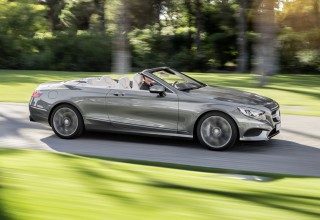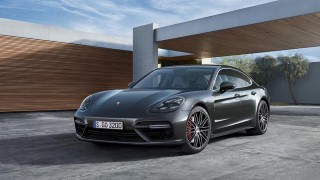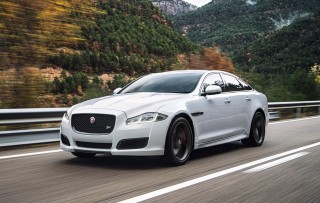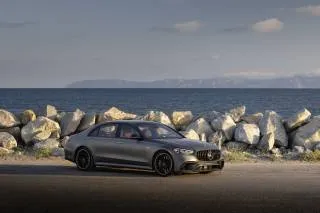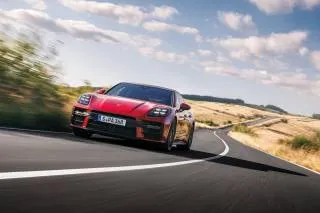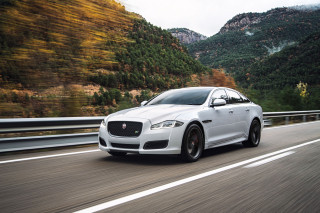Likes
- A (relatively) lightweight big sedan
- Spacious, isolated cabin
- Responsive driving experience
- iDrive goes touchscreen (and gesture-based)
Dislikes
- Only an evolutionary design
- Overload of active/anticipatory systems
- Even pricier than before
Buying tip
features & specs
The 2017 BMW 7-Series has a deceivingly conservative wrapper for its radically reengineered underpinnings and tech-centric cabin.
You can count on the BMW 7-Series to make a technological leap with each of its generations. And with the latest sixth-generation models that made their debut last year, the 7-Series is certainly no exception, as it benefits from some engineering lessons learned, inside and underneath, with the automaker's "i" electrified cars.
The 7-Series earned an 8.6 overall rating out of 10, which is an exceptional score for an exceptional car. (Read more about how we rate cars.)
Styling and performance
On the outside, you might mistake the 2017 BMW 7-Series for a vehicle not significantly different from that of a couple model years ago; yet this one is radically different within, with a new Carbon Core platform that uses a combination of carbon fiber-reinforced plastic (CFRP), ultra-tensile steels, and aluminum to cut up to 90 pounds there alone.
Lighter doors made of aluminum and lighter-weight suspension components are just a couple of the other changes; and they've managed to maintain a perfect 50/50 weight distribution.
After a decade or more of pushing boundaries with exterior designs, BMW seems committed to restoring some of its classic sport-sedan proportions. What it set in motion with the latest versions of the 3-Series and 5-Series sedans, it continues with the latest 7-Series—including more window glass, an upright, formal profile, and clean sheet metal. An especially upright version of the BMW family grille (an Active Kidney Grille that manages airflow) gives the look a somewhat more blunt nose, while otherwise the look is remarkably even-keeled—without the wedge-like upkick near the rear that's added to other sedan designs.
Inside, we'd call it a dose of retro-futurism, as the 7-Series incorporates an exaggerated horizontal look for the dash, combined with some up-close details that look to us to be borrowed from the i8 sports car—but then finished off with the formality of additional brightwork, including satin-finish tones for the climate and audio controls.
The 740i is motivated by a TwinPower turbocharged 3.0-liter inline-6 making 320 horsepower, with the 750i packing a 4.4-liter TwinPower turbocharged V-8 that produces 445 hp. For 2017, the 7-Series offers all-wheel drive for the 740i as well (it was only available in 750i form for 2016); and the BMW M760i xDrive now gets a twin-turbo V-12, making 600 hp and 590 lb-ft and capable of getting to 60 mph in 3.9 seconds. For performance enthusiasts, there's also the 2017 BMW ALPINA B7 xDrive, which includes Integral Active Steering, combining variable ratio electric steering system at the front axle with active steering on the rear axle. It can get to 60 in just 3.6 seconds and has various other performance upgrades.
At the other end of the spectrum is the new 740e xDrive iPerformance plug-in hybrid. It teams a 255-hp 2.0-liter turbocharged gasoline inline-4 engine, with a 111-horsepower electric motor that’s integrated within an 8-speed automatic transmission, and a lithium-ion battery pack. It can drive 14 miles on electricity alone at up to 87 mph and carries EPA ratings of 27 mpg combined and 64 MPGe.
The 740e is meant mostly to be used as a hybrid as the 111-hp motor can really only handle low-speed city driving duties. Use it as a hybrid or drive it in Sport mode, though, and it can use all of its 332 horsepower and 369 lb-ft of torque. That's good for a 5.1-second 0 to 60 mph time.
The twin-turbocharged 4.4-liter V-8 in 750i models works with the 8-speed automatic transmission to provide 445 silky smooth horses with little fuss. BMW says the 750i is capable of a 0-60 mph sprint in an incredible 4.3 seconds; that's the only model we've driven so far, but we don't anticipate the 740i feeling short on power in any way.
Underneath the 7-Series, a series of electronic chassis controls have become far more complex. An air suspension and electronically controlled dampers are standard on all models. An optional Autobahn package comes with a system called Active Comfort Drive with Road Preview, which adds anticipatory functions to the dampers, air suspension, and the included active roll bars. It also includes the Integral Active Steering (variable-ratio front and rear-wheel steering), which is engineered so it can work in combination with all-wheel drive.
The dampers, steering, throttle, and transmission are all adjustable in the standard Driving Dynamics Control system, which has Sport, Comfort and Comfort+ settings. In Sport mode, the available active roll bars help keep the car relatively flat through corners and wrestle its 4,600-pound curb weight around like a smaller, lighter car. We did notice, however, that the handling suffers without those roll bars and the Integral Active Steering, tending to push in corners instead of rotate. The Sport mode also makes the power more readily accessible, adds a little more heft and responsiveness to the steering, and provides more road feel without creating a firm ride. Overall we've found all these chassis systems, plus the weight savings of the new structure, to bring a far lighter, leaner driving experience than you'd expect from a sedan this large.
Comfort, safety, and features
BMW has pushed the corners of the 7-Series cabin outward as part of the revamped instrument-panel design; and it at least visually frees up a little more cabin space for those in front. For the U.S. market you'll only find long-wheelbase versions, with a (meaningful) extra inch of rear leg room. The back seat area, as it always has for the 7-Series, can be equipped for typical luxury-sedan accommodations or something far greater and chauffeur-worthy. New ambient lighting and a fragrance option help personalize the interior, while there’s a panoramic LED roof available. And all doors now have a soft-close feature.
Now that heated rear seats are more common, the 7-Series takes it a step farther, with heated armrests, front and rear. A Luxury Rear Seating Package adds those plus rear ventilated and comfort seats, and a removable Touch Command Tablet, with a wireless hotspot, for those in back. There’s also a massage function, and rear-seat passengers get a "Vitality Program" so that “passengers can engage in active training to revitalize the body on longer journeys,” according to BMW. Separately, there’s a Rear Executive Lounge Seating Package that gives the right rear passenger an extra 3.5 inches of leg room and a footrest. That package also includes a fold-out table, two cupholders, and a separate storage compartment.
Interface plays a big part in making the 7-Series' vast array of technology features useful and accessible. To that, there’s a new Gesture Control feature for the iDrive interface, as well as a newly available wireless charging system. The head-up display covers a larger area, and a second-generation Night Vision 2 system adds pedestrian detection, while new Adaptive Headlamps now take into account speed, steering angle and yaw.
BMW has finally caved to touchscreen technology. With iDrive 5.0, the 7-Series includes a big 12.3-inch landscape-oriented touchscreen. Bowers & Wilkins surround sound with 1,400 watts and 16 speakers should help take care of your entertainment needs, too.
2017 BMW 7-Series Styling
The 2017 BMW 7-Series is looks strong and substantial, with the boldest take yet on BMW's kidney grille.
The BMW 7-Series builds on the same classic sport-sedan proportions that you've come to expect from the brand—ones that have been reconfirmed in recent years with the current 3-Series and 5-Series models—and keeps the profile and sheet metal very clean, relative to many other models on the market.
The 7-Series is elegant inside and out—and then all over again. (Read more about how we rate cars.)
From the side profile, the changes are a little more apparent. A larger, taller version of the brand’s twin-kidney grille—a so-called Active Kidney Grille that manages airflow for efficiency—gives the front end a little more gravitas, while a beautifully sculpted beltline crease rises from the hood and continues, in very subtle fashion, all the way to the rear lamps and a chrome accent bar across the rear. Just behind the front wheelwells, a chiseled piece of brightwork starts and continues along the lower side of the vehicle, serving to lift the look somewhat.
Although the exterior is conservative to most eyes, the interior is quite the opposite; BMW has continued some of the design themes it’s already embarked upon with other recent vehicles, but maximized and exaggerated them, and brought some of the up-close details of the i8 efficiency-centric sports car. In terms of the overarching design and the lines, the instrument panel gets more shelf-like and horizontal than ever. Yet it remains quite formal, enforced by additional brightwork, including a satin-metallic look for the climate and audio controls.
2017 BMW 7-Series Performance
The 2017 BMW 7-Series follows a sporty track among modern luxury sedans; it's particularly agile.
The 740i is motivated by a TwinPower turbocharged 3.0-liter inline-6 making 320 horsepower, with the 750i packing a 4.4-liter TwinPower turbocharged V-8 that produces 445 hp. For 2017, the 7-Series offers all-wheel drive for the 740i as well.
Also new for 2017 are the 740e xDrive iPerformance plug-in hybrid model, the V-12-powered M760i xDrive, and the BMW ALPINA B7 xDrive. A new diesel model is still expected as well, though we don't know the timing or model year.
The 7-Series nearly aces our performance test, the only thing keeping it back is hyper horsepower from anything other than the Alpina B7. (Read more about how we rate cars.)
The plug-in hybrid 740e xDrive features a 2.0-liter turbocharged gasoline inline-4 engine making 255 horsepower and 295 pound-feet of torque, a 111-horsepower electric-drive unit that’s integrated within an 8-speed automatic transmission, and a lithium-ion battery pack mounted under the rear seat. This plug-in hybrid is able to go 14 miles on electricity alone, according to the EPA. However, this mode is limited to 87 mph. There’s also a Battery Control mode that allows drivers to maintain or gain battery charge, therefore saving the electric driving for dense urban areas.
The 740e is meant mostly to be used as a hybrid. With only 14 miles of range and just 111 horsepower to tote around a 4,740-pound car, the all-electric mode is best used just for low-speed city driving. Drive the 740e as a hybrid, though, or use it in Sport mode, and it can take advantage of its full 332 horsepower and 369 lb-ft of torque. With both the engine and motor working in tandem, the 740e can launch from 0 to 60 mph in a spritely 5.1 seconds, which is a match for the 740i xDrive.
The 750i's twin-turbocharged 4.4-liter V-8 and 8-speed automatic transmission are silky smooth, delivering all 445 horses with little fuss. BMW says the 750i is capable of a 0-60 mph sprint in an incredible 4.3 seconds
We haven't driven a 740i, but we don't expect it to feel short on power in any way.
The BMW M760i xDrive has a twin-turbo V-12 making 600 hp and 590 lb-ft and capable of getting to 60 mph in 3.9 seconds. And then there's the 2017 BMW ALPINA B7 xDrive, which includes Integral Active Steering, combining variable ratio electric steering system at the front axle with active steering on the rear axle. It can get to 60 in just 3.6 seconds and has various other performance upgrades.
Underneath the 7-Series, a series of electronic chassis controls have become far more complex. An air suspension and electronically controlled dampers are standard on all models. An optional Autobahn package comes with a system called Active Comfort Drive with Road Preview, which adds anticipatory functions to the dampers, air suspension, and the included active roll bars. It also includes the Integral Active Steering (variable-ratio front and rear-wheel steering), which is engineered so it can work in combination with all-wheel drive.
Even the 8-speed automatic transmission is now linked to navigation-system data, allowing the shift characteristics to change with curves and terrain. Automatic start-stop turns off the engine temporarily at stoplights, while the powertrain allows decoupled coasting at speeds up to 100 mph.
It's all built on a new “Carbon Core” platform made from high-strength steel, aluminum, and carbon fiber-reinforced plastic strengthens the structure and helps it shed some weight. To further reduce weight, BMW used lighter-weight suspension components to cut 15 percent of the unsprung mass, formed the doors and trunk lid from aluminum, employed lightweight bonding techniques, and added thermal and acoustic shielding to the engine to reduce the amount of sound insulation needed.
The lighter weight, a perfect 50/50 weight balance, and various suspension upgrades and technologies give the new 7-Series a sporty yet comfortable driving experience. With a double wishbone front suspension and five-link rear suspension, aided by a four-corner air suspension and electronically controlled dampers, the suspension can be set for a firm or comfortable ride, and it will even raise the vehicle about an inch for bumpy roads or lower it about a half-inch for better highway aerodynamics.
The dampers, steering, throttle, and transmission are all adjustable in the standard Driving Dynamics Control system, which has Sport, Comfort and Comfort+ settings. In Sport mode, the active roll bars help keep the car relatively flat through corners and wrestle its 4,600-pound curb weight around like a smaller, lighter car. It also makes the power more readily accessible, adds a little more heft and responsiveness to the steering, and provides more road feel without creating a firm ride. The Comfort mode dials down the steering and engine responses while smoothing out the ride, and Comfort+ introduces a bit of float to the ride.
As we found in the 740e, the 7-Series doesn't handle as well without the active roll bars and the Integral Active Steering. It leans more, and tends to push in corners instead of rotate, issues that are perhaps exacerbated by the 4,40-pound plug-in hybrid.
While the ride quality is certainly stellar, sharp bumps can pound through on occasion. Such is the danger of large wheels and low-profile tires. The steering, while light, is pleasantly quick, though some may find it to be a bit too direct in the Sport mode because it requires lots of minor corrections on the highway.
2017 BMW 7-Series Comfort & Quality
The cabin of the BMW 7-Series offers the highest-quality materials and brims with technology items.
Like the best big luxury-car interiors, the cabin of the 2017 BMW 7-Series is a place you'll seek out—a place you'll want to linger. With a new design that pushes corners outward, space has been maximized, while in back this model is as limo-like as ever.
We're giving the 7-Series our top score on comfort—like many in the segment—thanks to great interior space, comfort, fit and finish. (Read more about how we rate cars.)
Front seats in the 7-Series are as superb as you've come to expect in BMW's top sedan—a sweet spot between all-day comfortable yet supportive enough for curvy roads. In back, the seats are fine for three but downright luxurious for two. And buyers looking for even more luxury can opt for the Luxury Rear Seating Package, adding heated front and rear armrests and ventilated massage rear seats.
You can take that further with the Rear Executive Lounge Seating Package that adds 3.5 inches more right side rear leg room (thanks to a front passenger seat that moves farther forward), a footrest for the right rear seat, rear seat entertainment with two 10-inch screens, and a fold-out table.
Both of these packages come with a 7.0-inch rear Touch Command Tablet that lets rear seat passengers control such functions as seat adjustments, air conditioning, and the navigation, communications, and infotainment systems. Occupants can also use the tablet to surf the web via a built-in mobile hotspot.
Increasingly so, the interface has become an important part of interior functionality in luxury cars. BMW updated its iDrive control interface last year, adding touch capability to the center screen. But there's also the familiar iDrive controller, with a rotating central dial that includes a handwriting-sensitive touchpad, steering wheel controls, and voice recognition. After more than a decade of revising this system, iDrive works well to control the numerous functions offered in the 7-Series, though it still requires a learning curve. Some buyers may be turned off by fingerprints on the center screen.
A few select functions can be controlled yet another way through the new Gesture Control feature. Front seat occupants can turn up or down the volume, take or reject phone calls, and browse a 360-degree view of the vehicle with five different hand gestures. An additional double point gesture can be assigned to a list of possible tasks. The gestures need to be made above the iDrive dial so a 3-D sensor mounted above can recognize them. In our limited exposure to Gesture Control, we found it works fairly well. The system doesn’t always respond immediately, but another attempt usually gets the desired results.
You'll find the highest quality wood, leather, and metal materials and trims in the 7-Series; and beyond that, BMW has found new ways to pay attention to the details. Ambient lighting is standard, and it lights up the carpet when the doors are open to give entry a sense of occasion. Many of the buttons feature a thin layer of galvanized metal (making them warm or cool to the touch depending on the temperature), wood has been applied to out-of-the-way places like the base of each C-pillar, and BMW even offers adjustable mood lighting via lights that cover the B-pillars.
Further luxurious touches include diamond-stitched leather upholstery, an available Alcantara headliner, and hundreds of personalized options in BMW’s Individual program.
2017 BMW 7-Series Safety
In lieu of actual crash-test results, the 7-Series offers an unparalleled list of safety features—including some you probably hadn't heard of yet.
The 2017 BMW 7-Series hasn't been tested under either of the U.S. crash-test programs. And seeing that this model typically has a very low sales volume and both the NHTSA and IIHS try to test vehicles based on popularity, it's likely to stay that way.
We're withholding an actual score until more official data makes its way in. (Read more about how we rate cars.)
That said, the 7-Series builds on quite the reputation for occupant safety, and it includes a great set of standard safety features. The standard kit includes front side airbags, rear-seat side airbags, knee airbags, and front-seat active head restraints. New Adaptive Headlamps are also standard.
BMW also fits a rearview camera and parking sensors to assist drivers in keeping the 7-Series clear of parking-lot trouble.
Buyers can choose from quite the list of safety options. A second-generation Night Vision 2 system adds pedestrian detection. A Driver Assistance Package includes blind-spot detection and a lane-departure warning system, which vibrates the steering wheel when the car drifts from from the marked lane.
Attention Assist is standard across the lineup, and it monitors the driver's behavior and displays a coffee cup if it detects an unsafe level of fatigue.
The Driver Assistance Plus Package II is the option set that includes adaptive cruise control and active lane-keep assist, Side Collision Avoidance, and Traffic Jam Assistant.
In conjunction, the adaptive cruise control and Traffic Jam Assistant allow for semi-autonomous driving, following cars ahead and providing steering assistance to keep the car in its lane.
2017 BMW 7-Series Features
The 7-Series serves as a showcase for the latest technology—plus all the traditional comfort and convenience items, of course.
The 2017 BMW 7-Series is the pinnacle of technology for the brand and boasts some of the most forward-thinking programs from the Munich automaker.
It aced our features test thanks to its tech, toys, and tools, and can be one of the most lavishly equipped sedans on the planet. (Read more about how we rate cars.)
This year, BMW is making standard its display key, which instead of the usual key fob, buyers get a larger fob that has a 2.2-inch touchscreen. The screen allows drivers to monitor trip computer information like fuel level and estimated range, plus service requirements and the vehicle lock status. It has a range of about 1,000 feet and it can be recharged in the center console.
All 2017 7-Series have a long wheelbase that adds 1 inch of rear leg room.
The 750i models add nappa leather upholstery, multi-contour seats, 19-inch wheels, soft-close doors, a head-up display, and automatic high beams.
Options include a Panoramic Sky Lounge LED roof with LED modules that light up imprinted graphics, an Ambient Air Package that ionizes a choice of eight perfumes, and a 16-speaker, 1,400-watt Bowers and Wilkins surround sound audio system.
An Interior Design Package adds an Alcantara headliner, deep-pile rear floormats, and additional wood trim. The M Sport Package comes with an aerodynamic body kit, 19- or 20-inch M light-alloy wheels, larger brakes, illuminated door sill plates, and accents in either light or dark chrome. The Autobahn Package comes with active roll bars and Integral Active Steering, which is available as a stand-alone option otherwise.
In addition to extra horsepower, the Alpina B7 gets other features to improve performance. They include the active roll bars, electronic dampers with Alpina-programmed settings, the Integral Active Steering, 20- or 21-inch Michelin Pilot Super Sport tires, lightweight forged alloy wheels, and bigger brakes. For improved aerodynamics, it has unique front and rear spoilers to reduce lift on the front and rear axles without adding downforce. Inside, it gets a Lavalina leather-wrapped steering wheel, an Alpina-programmed instrument cluster, plush carpeted floormats, and various forms of Alpina insignia.
Cars built after July 2016, offer BMW's remote controlled parking feature that parks the 7-Series into a garage or parking space. This is available after federal rules were relaxed that requirement drivers to be behind the wheel at all times.
2017 BMW 7-Series Fuel Economy
The 740e plug-in hybrid will give the eco-conscious a new way to flaunt it, but the rest of the lineup is unremarkable for fuel economy.
The 2017 BMW 7-Series has a new hybrid model that is the fuel efficiency leader, but otherwise, most of the lineup is as thirsty as you'd expect from a big, heavy sedan.
The BMW 740i with all-wheel drive is rated by the EPA at 19 mpg city, 28 highway, 22 combined. Rear-drive versions are rated at 21/29/24 mpg.
We're basing our fuel economy rating on those models, which should comprise the most 7-Series sales in the U.S. (Read more about how we rate cars.)
BMW's 750i models feature a twin-turbocharged 4.4-liter V-8. Predictably, they score lower: 16/25/19 mpg with all-wheel drive, 17/26/20 mpg without.
An even more powerful version of that V-8 is found in the Alpina B7. It is rated at 16/24/18 mpg.
The thirstiest model is the new M760i xDrive, which is rated at 13/20/16 mpg.
The 740e xDrive iPerformance plug-in hybrid has the best ratings of the bunch. According to the EPA, it's rated at 27 mpg combined, and it has a 64 MPGe rating. It can be charged in less than three hours on a 240V outlet or under 7 hours on a 120V outlet.
In our 94-mile test of the 740e, we got 24.3 mpg, which is decent for such a big car, and we were not able to charge the car overnight. We also got 13.3 miles of electric range, though that was a little bit at a time, as we drove mostly in the Auto eDrive mode, which treats the car as a hybrid and measures electric range only when the motor is powering the car or the car is coasting and the engine is off.






































































































